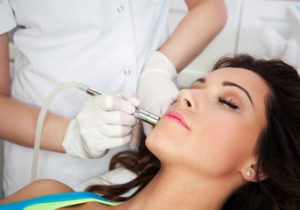Laser Skin Resurfacing

Also, within each technique, there is a range of possible procedures from light superficial procedures that will have minimal recovery but shorter lasting results to longer lasting procedures that require more recovery time. The overall improvement really depends upon how deep into the different levels of the skin the specific procedures extends. There is of course a limit to how deep any procedure can go to avoid unwanted scarring.
LASER
Dr. Liu is often asked about lasers regarding almost every procedure that he performs. Lasers are probably the most common method of facial skin resurfacing today. What most people do not understand are the following:
- There are many different types of lasers
- Each laser has a specific wavelength that gives it its unique properties- primarily depth of penetration and absorption
- These properties enable each laser to be highly effective at treating certain problems
- No two lasers are identical
Laser procedures are just like any other surgery. No two patients/lesions are exactly the same. Therefore, the interaction between the laser and patient is a unique process. Dr. Liu has two lasers in the office which will be described. Each has its own particular applications. For patients undergoing surgical procedures under anesthesia, these lasers can be taken to the operating room for combined surgical /laser procedures.
Aerolase Nd:YAG Laser
This laser does not require any pre-medication or anesthesia. Occasionally only ice is needed before the procedure. Many applications require several treatments for best results.
Applications Include
Hair Removal and PFB (ingrown hair) Removal
This particular laser is safe for all skin types (light and dark). 4-6 sessions are needed at 3-4 week intervals to achieve over 75% hair reduction. Each treatment should result in 15% or greater clearance of hair in the treated area. As with any hair removal laser, permanent hair removal is not possible, only permanent hair reduction. Every hair follicle has certain stages of growth. In any one particular area, the hairs are in different stages. The laser only works during one of the specific phases of growth. This is why several sessions are needed.
Vascular Lesions Angiomas, telangiectasias (fine vessels particularly on the face and legs). 1-3 or more sessions are required at 1-2 week intervals. Mild redness in the treatment area may ensue for a few days. The lesions may take 1-2 weeks to disappear or fade.
Pigmented Lesions (sun spots, age spots). May require more than one session. The lesions may shed at 1-3 weeks.
Photo Rejuvenation (skin tightening). Requires 5-6 sessions at 4-6 week intervals.
Aerolase Erbium:YAG Laser
This is a deeper penetrating laser for skin resurfacing and is an ablative laser along with the CO2 (carbon dioxide laser). Recovery is longer than with the Nd:YAG laser.. However, results are dramatic and long lasting. Next to the CO2 (carbon dioxide laser which can leave patients red for many months), the Erbium laser has the deepest penetration.
Applications Include
Wrinkle reduction is the most common. Requires topical/local anesthesia, sometimes intravenous sedation. Redness may last for 2-3 weeks. The skin will re-epithelialize in 2-7 days.
Ablation/Removal of many benign, pre-malignant and malignant skin lesions.
In general there are certain precautions everyone should take proper to any laser procedure:
- Avoid tanning for several weeks prior to any laser procedure since most lasers target pigmentation in the skin.
- Accutane should be discontinued months before treatment
- Patients with a history of recurrent herpes lip sores should be pre-medicated with an antiviral oral medication
- Any makeup or facial lotions/creams should be removed prior to any procedure.
- Report any history or poor scar formation beforehand.
Dr. Liu is featured in an article on facial laser procedures. Click on the image below to read the article in pdf format. Click on the image to the right if you need to download Adobe.
CHEMICAL PEELS
These procedures can be further divided into light, medium, and deep peels. Again, the deeper the penetration, the more dramatic and longer lasting the result, but the more recovery needed. Together with Dr. Liu, you can decide upon the best procedure for skin resurfacing that suits you individual needs and lifestyle.
The Obagi Blue Peel® is an example of a light-medium depth chemical peel. The Blue Peel® is a TCA (trichloroacetic acid) chemical peel that is performed in the office and typically should only be performed after the skin has been placed on a pre-peel skin regimen for maximum effect. Healing typically takes 10-14 days. Within the first day or two, the skin will turn red and begin to exfoliate. For maximal results, sometimes more than one peel is necessary. A chemical peel may often be combined with other surgical procedures.
DERMABRASION
This refers to physically “sanding” the skin to different depths to achieve the same results that chemical peels or lasers can achieve.
Click Here for additional information on these procedures from the American Academy of Facial Plastic & Reconstructive Surgery.

